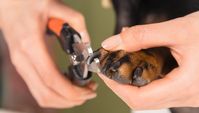
Along with a nutritious diet, plenty of exercise, and paying regular visits to the veterinarian, trimming your dog’s nails is another essential aspect of pet care. Long nails in dogs cause a number of ill-effects, from foot pain to problems with posture that can grow worse over time. This guide explains the best practices for nail trimming to reduce stress for both you and your pet.
4 Simple Steps to Trimming Your Dog's Nails
1. Invest in Quality Clippers
The better quality the clippers, the easier it is to trim your dog’s nails. Look for small, scissor-type clippers, which are the easiest to control. If the blades become dull, the clippers will need to be sharpened or replaced. Your veterinarian can likely offer recommendations for a particular brand.
2. Handle Your Dogs’ Feet Frequently
If you only ever come in contact with your dog’s feet during clipping sessions, they’re bound to grow uncomfortable with the prospect. Conversely, if you handle your dog’s feet at other, less stressful times, they won’t be as alarmed when it’s time to perform grooming.
3. Avoid Cutting Below the Quick
 Dog nails should be cut from under the paw, unlike human nails which are trimmed from above. Additionally, only cut small sections of the nail until you see the white inner part, which is known as the quick. The quick contains blood vessels and, when trimmed, it can cause bleeding and discomfort. If you do accidentally cut too much, use styptic powder to stop the bleeding.
Dog nails should be cut from under the paw, unlike human nails which are trimmed from above. Additionally, only cut small sections of the nail until you see the white inner part, which is known as the quick. The quick contains blood vessels and, when trimmed, it can cause bleeding and discomfort. If you do accidentally cut too much, use styptic powder to stop the bleeding.
4. Offer Treats & Praise
If your dog associates nail trimming sessions with tasty treats and affection, the process is bound to go much smoother. Using a kind, soothing tone is also beneficial, as it will put your dog at ease if they are stressed or anxious.
A trusted veterinarian can also walk you through the process involved with cutting your dog’s nails and providing other forms of pet care. In Lincoln, NE, A-4 Animal Hospital runs a full-service clinic, offering vaccinations, flea treatments, wellness exams, diagnostic testing, and surgical procedures. They also make house calls in the event you’re unable to transport your pet. Call (402) 475-2282 to schedule an appointment or visit the website for more information on their services.
About the Business
Have a question? Ask the experts!
Send your question

